 Today was a brilliant day. The first sunny day after a weekend of rain and clouds. I decided today would be a good day to ride my horse.
Today was a brilliant day. The first sunny day after a weekend of rain and clouds. I decided today would be a good day to ride my horse.
Sadly, it was not to be. As anyone who has kept horses will tell you: there are magical, wonderful days where you and the horse go galloping through fields and over fences and there’s wind in your hair and it’s all so amazingly awesome you can’t believe it’s real; and there are the days where you go to get your horse out of the pasture and she’s lying down. Or limping. Or stuck in the fence. Then it is not so awesome. Then it is phone calls to the vet and an exhaustive afternoon assessing damage, treating wounds, and so on. Usually it entails a good week or so of special treatment. Maybe penicillin shots if you’re unlucky. If you are especially unlucky it may necessitate a ride down to the vet, and then the stress (and bills) really start adding up.
Today it was a lame foot. Not the sort of subtle “is she limping? Is she not?” lame. This was the “Oh my god I have a three-legged horse!” lame.
Huh, I thought, I bet she has an abscess.
It is not uncommon for horses, especially in winter when the ground is wet, to develop infections inside their hooves. These are called abscesses. Typically you don’t know your horse has one until one day you find they are limping around their paddock on three legs. Then you have the vet out, and they poke around and try to dig out the abscess so it can drain. Some abscesses burst on their own. You can tell they have burst because smelly pus is spilling out of your horse’s hoof… and suddenly they are not lame any more.
This is more or less what happened today. Although the vet wasn’t able to pop it, she was able to pinpoint where the abscess was, and dug partway into the hoof so that it would be encouraged to drain down. Now it is a matter of soaking the foot twice a day in warm epsom salt water, and packing it with tincture of iodine for the rest of the time. We also give an oral painkiller called “bute” to make the horse more comfortable.
All this I’ve done before. In fact, apart from epsom salt and duct tape, I had all the necessary supplies for dealing with an abscess already on hand.
“That’s nice,” my vet said. “We still have clients who have either been very lucky, or just haven’t had their horse for very long, who panic at the first sign of an abscess.”
That is the thing about abscesses. Yes they are painful, and a pain in the ass to deal with, but compared to other common equine ailments they are remarkably low-risk and straightforward to treat. Unlike colic. Or chronic laminitis. Bone spurs or navicular syndrome. Or mysterious joint problems.
My horse, Emmy, has had abscesses in her feet at least twice that I can distinctly remember, perhaps more (they all blur together after a while). The first time it was in her front foot and I had no idea what was going on. The vet came up and punched a hole in the sole of her foot, and out came this truly nasty liquid, and she felt much better at once.
The second time she came down severely lame on her right hind foot… at a horse show… in Nevada. There was no vet, but the on-site chiropractor helpfully diagnosed it as a problem with her stifle, or knee joint. Stifle injuries are seriously business, and there were a tense few days until we were able to get her to our vet and their very expensive imaging equipment showed that her stifle was in excellent condition.
At this point my Wonderful Mother (I was only 13 at the time) took the initiative to call the man who would become our current vet. But his wife was having a baby. His sub came out instead. In the mean time Emmy had sprouted an odd, oozing sore on the coronet band (the border between the hard hoof and the furry leg) of her right hind foot. The substitute vet took one look at that and rolled her eyes.
“With lameness in horses, 97% of the time it is below the knee,” she said. And proceeded to dig a second drain so the abscess could drain more rapidly. Emmy made a speedy and complete recovery, and has never to date had any problems with her stifles.
Treating an abscess in the hoof is simple but not easy. One must soak the hoof in warm epsom salt water, either in a bucket, or with a special “soaking boot”. I had purchased a pair of these after the last abscess, when I had been repeated soaked with epsom salt water when my horse knocked over the bucket, and had not had to use them for over five years. I used one today, and it was infinitely easier.
Winter is abscess season here. No sooner had the vet finished with Emmy than my trainer had self-diagnosed an abscess in one of her horses. So my other soaking boot was put to use.
After soaking it is a matter of packing the hoof with iodine. The iodine is easy: just pour it over the affected area. Keeping it clean is another thing: I find disposable diapers, held in place and coated with an armor of duct tape, to work well, but they must be replaced at least once a day or they wear off, tear off, or fall off.
Once the abscess bursts it is only a matter of keeping the pathway open so it drains entirely, which takes anywhere from 24-48 hours.
“With luck,” the vet said, “she’ll be a hundred percent again by Friday.”
That is the plan, for now. Tomorrow morning I will be back over with the soaking boot, and more epsom salts. I hope she is better by Friday: if I have to wrap her foot for much longer than that I will need to buy more diapers.

In other news: Radio Grimbald is back online. This season I’m reading the first volume of the Bouragner Felpz Adventures, so why don’t you check it out? And if you can, buy the eBooks. Vet farm calls ain’t cheap.
Goldeen Ogawa has been a horse-owner since 1999, and has had only one horse for that entire time; it has been more than enough work. She loves all horses, but Emmy is special. They can communicate telepathically, just not very well.
Comments and/or condolences can be sent to goldeenogawa@gmail.com, or posted in your own blog and tweeted to @GrimbyTweets.



























